Mosaic for the kitchen on the apron: varieties and recommendations for installation

Mosaic for decorating a kitchen apron is a very interesting alternative to the usual finishing of an apron with various traditional and modern materials. This original idea will help you transform your kitchen almost beyond recognition, will give its appearance a unique and catchy flavor.

Advantages and disadvantages
Like any decor ideas, mosaics have quite serious advantages, as well as certain disadvantages, considering which you must make a final decision - whether you opt for a catchy mosaic for decorating an apron in your new kitchen. Advantages of a mosaic apron:
- looks stylish and unusual, allows you to select various kinds of compositions and images;
- a rich selection of all kinds of colors and the most demanded shapes for any, even the most demanding taste;
- suitable for classic and modern rooms;
- resistance to moisture, which is important for rooms like a kitchen;
- resistance to damage;
- resistance to high temperatures and their drops;
- will not fade in the sun, will keep colors and patterns for a long time.
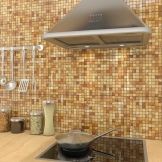



True, one must also take into account the fact that such a catchy apron finish will have disadvantages:
- a mosaic apron will look beautiful only with constant care, which must be done from the very first minutes after laying;
- the installation of the mosaic itself is a very complex process when compared with the installation of classic tiles;
- there will be many seams, which means that this finish is vulnerable to moisture, dirt, mold, and therefore you will need to constantly process the space between the chips in order to preserve the beautiful appearance of the product, you will have to purchase special remedies for fungus and mold with a water-repellent effect ;
- Compared to other decorating ideas, mosaics are quite an expensive choice.


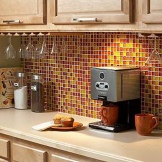

Types of material
Materials for decorating mosaic aprons can be anything from stylish glass to luxurious plastic. They must comply with rather stringent requirements in order to withstand certain specific conditions: to be resistant to moisture and temperatures, not to be afraid of the influence of various chemical environments and cleaning components. Any of these materials has its own pluses and minuses, which often affect the final choice.

Ceramic mosaic
Ceramic mosaics and standard tiles do not differ significantly. This type of design has increased resistance to various temperatures and humidity, has a huge number of different design options, and will last for a long time. The ceramic mosaic looks bright and colorful, sometimes it seems that it is made by hand.



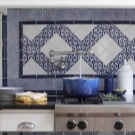


Among the disadvantages, one should mention the cost - such ceramic products will cost more than the usual tiles, and it will also be necessary to purchase a significant amount of grout for them. The kitchen mosaic made of ceramic chips is very inferior to the mosaic made of the same glass in terms of the choice of colors, but it offers much more textured ideas. It can have a matte or gloss, it can imitate antiquity, smooth pebbles or any other stone.

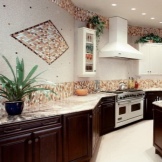


Glass mosaic
Glass aprons are one of the most popular among ordinary people. They will be inexpensive, last longer than other materials, and are much easier to care for. Due to the small parameters of the tile and firing at elevated temperatures, it stands out for its excellent strength and is much more reliable than ordinary glass. There are several types of such a mosaic.
- Homogeneous. Oversized glass tiles have a special gloss and look like lollipops, and if they have a matte finish, they will resemble pieces of glass that were carried by waves on the coastal sand. Glass cubes of this kind are often decorated with glitter or foil.
- From smalt. This is a type of colored glass that was pressed and baked at elevated temperatures along with metal oxides. Smalt is considered a very durable material, it can even often be found as a stylish floor covering. This glass is distinguished by its inimitable and rich colors and glowing effect from the inside. Each of the tiles of this material has a special shade, which sometimes creates a visual effect of the unique work of an artisan. The texture of the glass will depend on the additives or coatings used, for example, it often has a catchy pearlescent sheen.
- Glass with mineral inclusions - an original idea for a kitchen mosaic. The sparkling effect will create the illusion that the apron is lined with precious stones; for this, aventurine is added to the glass mass, and even more often - iridium. Glass with inclusions of minerals is not cheap, but it can give the kitchen an exclusivity effect.


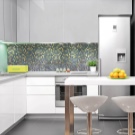
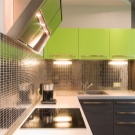


Stone mosaic
The mosaic made of real stone is very peculiar. The stone is considered the most durable and very interesting material, but it also has pores in its structure. In order to preserve the exquisite appearance of such a product for a long time, it must be treated with a special composition that fills the pores and makes it easier to care for the apron. At the same time, experts do not advise building an apron from soft rocks, as they will quickly absorb various liquids, such as red wine or juice from berries. Subsequently, it will be incredibly difficult to wash such stains.




The texture of this kind of mosaic is polished or may have certain roughness on the surface, and buyers often opt for aprons with elaborate and embossed ornaments or carved patterns. The stone can be combined very interestingly with other popular surfaces.
Porcelain stoneware product
The mosaic is sometimes constructed from porcelain stoneware. It is called a chic substitute for kitchen stone mosaics because of its excellent durability. Porcelain stoneware, however, has a rather small selection of colors - only all brown shades.




Mother-of-pearl mosaic
Mother-of-pearl is a beautiful and graceful material, it has the ability to reflect and also dim light, making it soft and absent-minded. Such a product has iridescent tints. If it is natural mother-of-pearl, then this kind of finish will not be cheap.


Metal mosaic
Mosaics of this kind are not entirely made of metal, as this is too heavy for ordinary walls. Most often, the basis of the mosaic is ceramics, and rubber or plastic is also used, which have a brass or bronze coating on top. This type of mosaic helps manufacturers imitate gold or steel. An apron made of metal mosaic is extremely durable, practical, the only drawback is that the metal coating loses its luster over time.




Mirror mosaic
Mirror mosaic tiles are among the most durable, but they need to be looked after carefully. Usually these are chips in the form of a rectangle or square. They are also available tinted. Mirror glass is an environmentally friendly material, it does not grow mold or mildew, and any stains that appear can be easily wiped off with a cloth and glass cleaner.




Whatever type of decoration you choose in the end, decorating an apron with a mosaic will become one of your most stylish and original ideas. This catchy, beautiful and very practical decor option will perfectly emphasize your great taste.
How to choose a mosaic?
When decorating the wall, the mosaic for the kitchen will look very attractive, therefore when choosing a decor method, you should take a closer look at the four main options for a likely color scheme.
- Monocolor. Such a mosaic will be laid out from modules of the same color and the same type. More often, this kind of solution is relevant for single-color kitchens - it will look great in a white or red kitchen.
- Mix. Apron mosaic is selected from different shades, but only one color and randomly. More often, such decor is found in rooms that are decorated in several colors.
- Stretch (gradient). A distinctive feature of this solution is the shape of a rectangle on a scale of 1 to 5. The mosaic is laid out on an apron made of tiles of the same color - from saturated tones to less catchy shades, for example, from rich grassy green to faded asparagus or even light green. Most often, however, this idea is used in bathrooms, not in kitchens.
- Panel. The mosaic is typed in the form of some image or original ornament, such an apron can rightfully become the main theme in the kitchen.



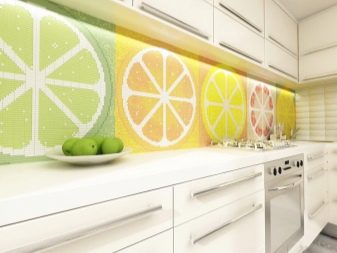
From the mosaic, you can easily make all kinds of compositions with unusual plots, bright ornaments, stylish patterns. The choice of colors of the elements from which the mosaic is created is simply amazing. You can easily find dozens of tones of the same color that differ from each other in saturation.
An unusual design will turn out if you successfully combine various mosaic options. Often on aprons you can see combinations of glass chips and ceramics, as well as stone and metal. Modern companies produce already prepared decor options, where certain surfaces are combined - for example, stone and glass. Large building markets often arrange profitable sales, where you can buy the remains of expensive and chic mosaics at low prices. These leftovers are perfect for creating your own signature mix.
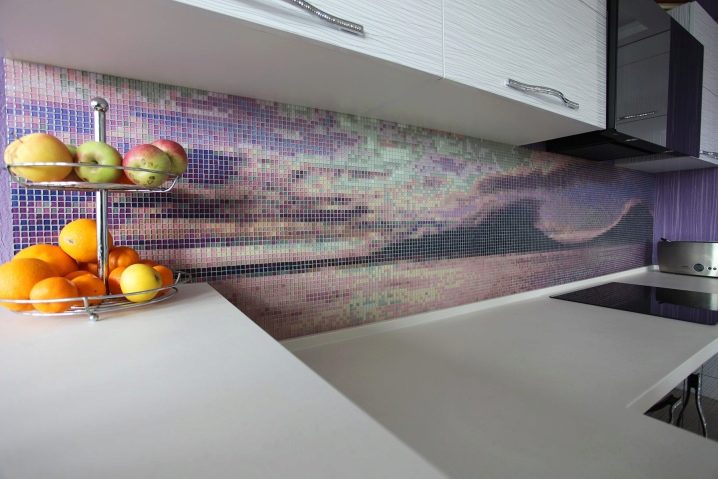
Styling tips
A ready-to-install mosaic is implemented in special matrices - these are squares of several elements, which are often called chips. The one-piece matrix is fixed on the already prepared wall. You can fix the product in three ways:
- using jumpers of the polymer type;
- gluing to the polyurethane mesh on the back of the matrix;
- using a paper base (it is glued to the front side of the matrix, it is removed only before the grouting stage).

Experts believe that the worst option for fixing the mosaic on the wall is polymer lintels, because they can break off when laid. It is best to choose the second option - a tile on a grid, it will definitely not tear and is very easy to stick. If you want to glue the mosaic yourself, then some helpful tips will come in handy.

Preparation of the base
The wall needs to be properly leveled, cleaned and dried - you can start laying the mosaic only 7-8 days after the end of all preparatory work. For the final leveling of the wall surface, white putty is often chosen.

Markup
In order for the new apron to look neat and as even as possible, the mosaic should first be laid on the floor at a certain interval, approximately calculating the dimensions of the joints between the tiles. The layout that will turn out is gradually transferred to the wall without fail, with notes of all parameters. The more accurate these markings come out, the better you will lay the mosaic.

Dilution of glue
The glue is diluted so that it looks like sour cream in consistency. You do not need to knead the entire volume of glue at once, otherwise it will quickly harden.

Product display
To fix the product, you first need to apply glue to the wall - using a special spatula with a smooth surface, then it must be leveled with a spatula with special teeth in the form of squares. Further, the calculation is made according to the existing markup, and then the matrix is already fixed. At this stage, the product can still be neatly leveled and, if necessary, even trimmed neatly.

When fixing the mosaic, do not press too hard on it so that the glue does not go beyond the seam. If this happens, a smaller notched trowel should be used. In most cases, this means that the wall under the apron is not properly aligned.
Rubbing existing seams
As soon as the glue dries, which will take about 3-3.5 hours, the paper or film can be removed from the mosaic. If your product is based on paper, then remove it by first moistening it with a wet sponge. The film should be removed diagonally, the remaining glue is washed off with a regular sponge. Now the mashing of the existing seams begins. The grout compound, pressing, is applied with a rubber spatula and gently spread across the mosaic vertically and horizontally, while removing excess glue diagonally. An hour later, when the grout is still solidified, the remnants of the composition can be removed with a damp sponge without washing the grout out of the joints. If it is not easily washed off, then you can wipe the mosaic with a solution of alkali, and then gently rinse it off. After that, you just have to polish the finished apron with felt or a bike.

Examples in the interior
The most common tile shape is square. It is extremely convenient when laying mosaics, when calculating the consumption of material, it can perfectly fit into any complex interiors.



A mosaic for a kitchen made of onyx or marble looks very expensive. Chips made of this material are quite large, which makes them stand out among other materials.



The contrast of stone and glass surfaces on the kitchen backsplash looks very impressive.

A honeycomb apron will become a warm accent in your interior.

See the next video for more details.













The comment was sent successfully.